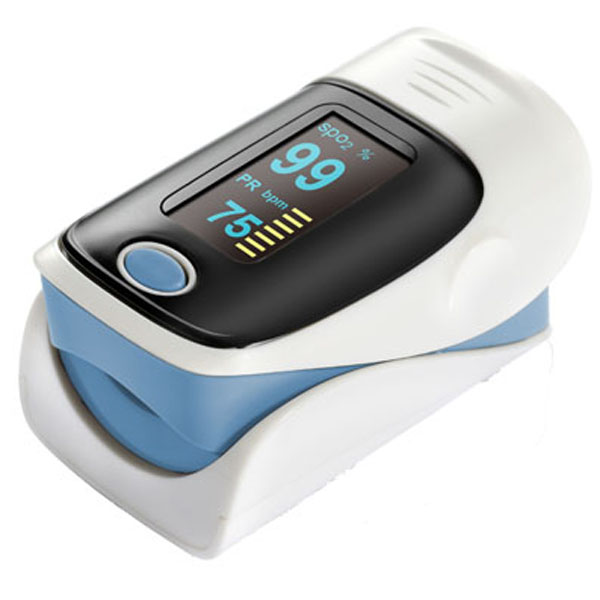Understanding Blood Oxygen Monitors
● Definition and Purpose
Blood oxygen monitors, often referred to as pulse oximeters, are essential medical devices used to measure the oxygen saturation level in the blood. These monitors are crucial in determining how effectively oxygen is being transported to different parts of the body, ensuring that vital organs receive adequate oxygen to function properly.
● How They Function
Pulse oximeters work by emitting a light through a relatively transparent area of the skin, typically a fingertip or earlobe. The device measures the amount of light absorbed by oxygenated and deoxygenated hemoglobin, providing an estimate of oxygen saturation. This non-invasive and painless procedure provides immediate results, making it a vital tool for both medical professionals and at-home users.
● Types of Devices Available
There are various types of blood oxygen monitors available on the market, ranging from simple finger-clip devices to more advanced, continuous monitoring systems. Custom Blood Oxygen Monitors, ODM Blood Oxygen Monitors, OEM Blood Oxygen Monitors, and devices from Wholesale Blood Oxygen Monitor suppliers cater to different needs and preferences, ensuring accurate and reliable readings.
Importance of Monitoring Oxygen Levels
● Role of Oxygen in the Body
Oxygen plays a crucial role in the human body, facilitating cellular respiration and energy production. It is transported by red blood cells to various tissues and organs, ensuring their proper function. Monitoring blood oxygen levels helps in detecting potential issues early, preventing severe health complications.
● Implications of Low Oxygen Saturation
Low oxygen saturation can lead to a condition known as hypoxemia, which can cause symptoms such as shortness of breath, rapid heartbeat, confusion, and cyanosis. Prolonged low oxygen levels may result in organ damage or failure, highlighting the importance of regular monitoring with a blood oxygen monitor.
● Conditions Benefiting from Monitoring
Various medical conditions require close monitoring of oxygen levels, including chronic obstructive pulmonary disease (COPD), asthma, heart failure, and pneumonia. Blood oxygen monitors are indispensable tools for individuals with these conditions, helping to manage and track their health effectively.
Health Conditions That Benefit
● Respiratory Conditions and Monitors
Individuals with respiratory conditions such as COPD, asthma, and chronic bronchitis greatly benefit from using blood oxygen monitors. These devices help in assessing the severity of their condition and the effectiveness of treatments like bronchodilators and supplemental oxygen therapy.
● Cardiovascular Diseases and Oxygen Levels
Patients with cardiovascular conditions, including heart failure and coronary artery disease, often experience fluctuations in oxygen saturation. Regular monitoring with a blood oxygen monitor manufacturer provides valuable insights into their condition, helping to adjust treatment plans accordingly.
● Monitoring in Infections and Other Illnesses
Infections such as pneumonia and COVID-19 can critically impact oxygen saturation levels. Continuous monitoring with devices from a Blood Oxygen Monitor factory or Blood Oxygen Monitor supplier ensures timely detection of deteriorating conditions, allowing for prompt medical intervention.
Pulse Oximetry in Daily Life
● Integration into Personal Health Routines
Blood oxygen monitors are not limited to clinical settings; individuals can incorporate them into their personal health routines. Regular monitoring can provide insights into overall health, helping to detect potential issues early and seek appropriate medical advice.
● Use in Exercise and Fitness Regimens
Athletes and fitness enthusiasts use blood oxygen monitors to assess their oxygen saturation during workouts, ensuring optimal performance and recovery. These monitors help in tracking progress and adjusting training routines for better results.
● Role in Sleep Monitoring
Sleep disorders such as sleep apnea can cause significant drops in oxygen levels during sleep. Blood oxygen monitors are used to track nocturnal oxygen saturation, aiding in the diagnosis and management of sleep-related conditions.
Benefits for Vulnerable Groups
● Use in Neonatal Care
Blood oxygen monitoring is critical in neonatal care units, where premature infants often require close observation. Monitors alert medical staff to any drops in oxygen saturation, ensuring immediate intervention and reducing the risk of complications.
● Applications in Elderly Care
The elderly population is more susceptible to respiratory and cardiovascular issues. Regular monitoring with a blood oxygen monitor helps in detecting potential problems early, allowing for timely medical care and improved quality of life.
● Monitoring Chronic Disease Patients
Patients with chronic diseases benefit from having access to blood oxygen monitors, enabling them to manage their conditions more effectively. These devices provide real-time data, helping to make informed decisions about treatment and lifestyle adjustments.
Providing Peace of Mind
● Reducing Anxiety with Real-time Data
For individuals with health conditions or those prone to anxiety about their health, blood oxygen monitors offer reassurance by providing immediate data on their oxygen levels. This real-time feedback can alleviate concerns and promote a sense of control over one’s health.
● Empowerment through Self-monitoring
Blood oxygen monitors empower users by allowing them to take an active role in monitoring their health. This self-monitoring capability encourages individuals to make informed decisions and engage in proactive health management.
● Testimonials from Users
Numerous users have shared positive experiences with blood oxygen monitors, highlighting the peace of mind these devices provide. Testimonials often emphasize the improved health outcomes and heightened awareness achieved through regular monitoring.
Limitations and Risks
● Potential for False Readings
While blood oxygen monitors are generally reliable, there is a risk of false readings due to various factors such as poor circulation, nail polish, or improper device placement. Users should be aware of these limitations and ensure proper usage to obtain accurate results.
● Factors Affecting Accuracy
Environmental factors, such as bright ambient light and user movement, can impact the accuracy of blood oxygen monitors. Choosing a high-quality device from a reputable blood oxygen monitor factory or supplier can mitigate these issues.
● Understanding Device Limitations
Users should understand that blood oxygen monitors are not substitutes for professional medical advice. While they provide valuable data, a healthcare professional should always interpret the results and provide guidance on any necessary actions.
Choosing the Right Device
● Key Features to Look For
When selecting a blood oxygen monitor, consider features such as accuracy, ease of use, battery life, and display readability. Custom Blood Oxygen Monitors, ODM Blood Oxygen Monitors, and OEM Blood Oxygen Monitors offer a range of options to suit different needs and preferences.
● Comparing Consumer-grade vs. Professional Models
Consumer-grade models are suitable for general monitoring, while professional models offer enhanced features for clinical use. Consult with a healthcare professional or blood oxygen monitor supplier to determine the best option for your needs.
● Reviews and Recommendations
Before purchasing, read reviews and seek recommendations from trusted sources or healthcare providers. Wholesale Blood Oxygen Monitors from reputable manufacturers like Leis often come highly recommended for their quality and reliability.
Tips for Effective Use
● Proper Placement and Fit
Ensure the monitor is properly fitted, and placed on a clean, dry finger or other recommended site. This helps achieve accurate readings and prevents false alarms.
● Logging and Interpreting Results
Maintain a log of your blood oxygen readings to track changes over time. This record can be useful during medical consultations, providing comprehensive data for healthcare professionals to analyze.
● When to Consult a Healthcare Professional
If your blood oxygen levels consistently fall below normal ranges, seek medical advice immediately. A healthcare professional can help identify underlying causes and recommend appropriate interventions.
Future of Blood Oxygen Monitoring
● Advancements in Technology
Technological advancements continue to enhance blood oxygen monitors, with improvements in accuracy, portability, and user interface. The integration of smart technology promises even greater convenience and connectivity.
● Integration with Smart Devices
Many modern blood oxygen monitors now connect to smartphones and other smart devices, providing seamless data tracking and analysis. This connectivity facilitates better health management and communication with healthcare professionals.
● Potential New Applications and Research Directions
Ongoing research explores new applications for blood oxygen monitors, including their use in remote patient monitoring and telemedicine. These developments hold promise for expanding the capabilities and reach of these vital devices.
About Leis
Leis is a leading and fast-growing medical supplier dedicated to the research, design, and development of high-quality medical devices. Our experienced team provides exceptional service to families and hospitals alike, with a product line that includes home-care medical instruments, diagnostic equipment, and medical consumables. Committed to quality and innovation, Leis strives to build long-term partnerships with customers worldwide, ensuring satisfaction through reliable products and exemplary customer service.

